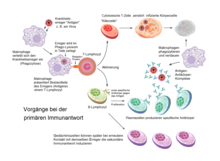Humoral immunity
![]()
This article or subsequent section is not sufficiently supported by evidence (e.g., anecdotal evidence). Information without sufficient evidence may be removed in the near future. Please help Wikipedia by researching the information and adding good supporting evidence.
Humoral immune response (from Latin [h]umor = moisture also juice, fluid) is the part of the body's immune response mediated by the non-cellular components of body fluids. Together with the cellular immune response, it forms the immune system of higher organisms.
Multicellular organisms have a number of different ways of defending themselves against foreign substances. For example, there are a large number of defence cells that help to prevent living organisms from becoming ill. The humoral immune response takes place in fluid media of the body, e.g. in the blood or lymph, and serves to combat viruses and bacteria in the extracellular space.
One group of these defense cells found in mammals is the lymphocytes. There are two major families of lymphocytes, the B lymphocytes and the T lymphocytes. While the T lymphocytes are capable of destroying or eliminating whole cells or parasites, the B lymphocytes use a different method of defense. They produce proteins called antibodies that bind to antigens and render them harmless. When a B lymphocyte recognizes an antigen, the structural features of the pathogen are presented on its surface. Once this occurs, the B lymphocytes proliferate and differentiate into plasma cells and memory B cells. The plasma cells begin producing specific antibodies and release them into the body fluids. These antibodies then bind with the surface proteins of the antigen, marking the foreign substance. This ultimately leads to its destruction or excretion.
The humoral immune response can be fundamentally divided into three phases:
- Activation phase
- Differentiation phase
- Effector phase
The humoral immune response starts when there has been an infection of the body by antigens. Macrophages are permanently in the tissues and vascular systems in search of foreign bodies.

Schematic sequence of the humoral immune response
Activation Phase
When an antigen (virus or bacteria) enters the body, it is recognized by macrophages as foreign by scanning the surface. The antigen is then first enclosed and taken up (phagocytosed) by the macrophages and then enzymatically broken down (lysed) in the cytoplasm.
The macrophages then present fragments (epitopes) of the antigen on the surface at the MHC class II receptors of their cell membrane. Here, a differentiation between endogenous and exogenous substances takes place through MHC class II proteins (self-foreign differentiation). By releasing cytokine IL 1 (interleukin-1), a kind of hormone of the macrophages, the T-helper cells (CD4+ cells) are induced to make contact with the presented antigen on the MHC class II receptor with their T-cell receptors. The contact is enhanced by CD4. By releasing interleukin-2, the now activated T helper cells are induced to differentiate. This also converts some T-helper cells into regulatory T-cells, which terminate the immune response after some time by releasing specific proteins.

Simplified scheme of the processes involved in the primary immune response
Differentiation Phase
An activated T-helper cell makes contact with a B-lymphocyte that has recognized the same antigen (B-epitope) with the help of its immunoglobulin receptor and now in turn presents the T-epitope on its surface via MHC class 2 and activates it by releasing cytokines. The activated B lymphocyte forms B plasma cells and memory B cells. The memory B cells are long-lived and provide a more rapid and effective immune response upon secondary contact with the antigen. The plasma B cells produce antibodies that render the pathogen harmless. The production of these antibodies takes place in the rough endoplasmic reticulum (ER). There, a kind of "basic form" is translated at the ribosomes, which can only bind to the epitopes of the antigens through the use of specific enzymes that cut the variable epitopes according to template (the epitopes of the antigens).
From primary contact with an antigen to the appearance of relevant amounts of antibodies typically takes several days in humans, but depending on the antigen and many other factors it can take weeks (latency period).
Questions and Answers
Q: What is the humoral immune system?
A: The humoral immune system is a part of the immune system which defends the body against invading organisms and other foreign material.
Q: What does the humeral part of the immune system do?
A: The humeral part of the immune system is done by macromolecules outside the cells, which may be secreted antibodies, complement proteins, or certain antimicrobial peptides. Their job is to attack bacteria (and other foreign substances) which are loose in the blood stream or other fluids.
Q: What were these fluids that were called "humors" in the olden days of medicine?
A: The fluids that were called "humors" in the olden days of medicine are the blood stream or other fluids that have bacteria (and other foreign substances).
Q: What are the components of the humoral immune system?
A: The components of the humoral immune system are secreted antibodies, complement proteins, or certain antimicrobial peptides.
Q: What kind of immune system has the humoral immune system present in it?
A: Both the more primitive innate immune system, and the later acquired or adaptive immune system of vertebrates, have humoral components.
Q: What is the difference between the humoral immune system and cell-mediated immunity?
A: The humoral immune system defends the body against invading organisms and other foreign material with macromolecules outside the cells, while the cell-mediated immunity involves the activation of phagocytes, antigen-specific cytotoxic T-lymphocytes, and the release of various cytokines in response to an antigen.
Q: What does the humoral immune system attack?
A: The humoral immune system attacks bacteria (and other foreign substances) that are loose in the blood stream or other fluids.
Search within the encyclopedia